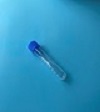
Growth Differentiation Factor 15, Plasma-994
Test info
Alpers Disease
Barth Syndrome (3-Methylglutaconic Aciduria, Type II)
Ataxia Neuropathy Syndrome (ANS)
CoEnzyme Q10 Deficiency
Complex I Deficiency Complex II Deficiency
Complex III Deficiency
Complex IV Deficiency
Complex V Deficiency
Cytochrome C Oxidase (COX) Deficiency
Chronic Progressive External Ophthalmoplegia (CPEO)
Kearns-Sayre syndrome (KSS)
Lactic Acidosis
Leber's Hereditary Optic Neuropathy (LHON)Leigh Disease or Syndrome
Myoclonic Epilepsy Myopathy Sensory Ataxia (MEMSA)
Mitochondrial encephalomyopathy lactic acidosis, and stroke-like episodes (MELAS)
Myoclonic Epilepsy with Ragged-Red Fibers (MERRF)
Mitochondrial Recessive Ataxia Syndrome (MIRAS)
Mitochondrial Cytopathy
Mitochondrial DNA Depletion
Mitochondrial Encephalopathy
Mitochondrial Myopathy
Mitochondrial Neurogastrointestinal Encephalopathy (MNGIE)
Neuropathy, Ataxia, and Retinitis Pigmentosa (NARP)
Pearson Syndrome
Pyruvate Carboxylase Deficiency
Pyruvate Dehydrogenase Deficiency
POLG Mutations
Respiratory Chain Defects
Sensory Ataxia, Neuropathy, Dysarthria, Ophthalmoplegia (SANDO)
Spinocerebellar Ataxia with Epilepsy (SCAE)
Mitochondrial biomarker
A circulating biomarker in myopathy-related mitochondrial disease as well as other conditions
Investigation of patients suspected of having a mitochondrial myopathy
For more information see:
Epilepsy: Unexplained Refractory and/or Familial Testing Algorithm
This assay is not suitable for carrier detection.
This test is not recommended for infants younger than 3 months of age due to the high levels of growth differentiation factor 15 contributed from the placenta during pregnancy.
Specimen
Immediately after collection, mix tube thoroughly by gentle inversion, 8 - 10 times, to prevent clotting
- Spin immediately
- Transfer plasma into screw cap transfer vial/tube (Mayo T914)
- Do not expose specimen to heat or direct sunlight.
- Spin immediately
- Transfer plasma into screw cap transfer vial/tube (Mayo T914)
- Do not expose specimen to heat or direct sunlight.
Refrigerated (preferred) - 90 days
Frozen – 90 days
Ambient – 28 days
Gross hemolysis
Gross lipemia
Gross icterus
Performance
Enzyme-Linked Immunosorbent Assay (ELISA)
Growth differentiation factor 15 (GDF15) ELISA is a quantitative sandwich enzyme immunoassay technique. Specimen is incubated in wells that have been coated with anti-GDF15 antibody. After incubation and washing, the wells are incubated with an enzyme-linked polyclonal antibody specific for human GDF15. After a second incubation and washing step, the wells are incubated with a substrate solution producing a blue color. A stop solution is added turning the blue color to yellow, which is then read at 450 and 570 nm on a microplate reader. The absorbance at 570 is subtracted from the absorbance at 450 to correct for optical imperfections and the resulting absorbance is directly proportional to the level of GDF15 in the specimen.(Package insert: Human GDF15 Immunoassay. R and D Systems, Inc; 2014)
Clinical and Interpretive info
*Three (3) months and older: < or = 750 pg/mL
*This test is not recommended for infants younger than 3 months of age due to the high levels of growth differentiation factor 15 contributed from the placenta during pregnancy.
Mitochondria perform many important metabolic functions, the most vital being the production of energy in the form of adenosine triphosphate (ATP) through the electron-transport chain and the oxidative phosphorylation system, which consists of 5 complexes (complex I-V). Each of these complexes consists of 4 to 46 subunits encoded by both nuclear and mitochondrial DNA. Mitochondrial diseases are caused by defects in any of the relevant metabolic pathways and have an estimated prevalence of 1:8500. Mitochondrial diseases are varied and include mitochondrial DNA deletion syndromes such as Kearns-Sayre syndrome (KSS), mitochondrial depletion syndromes such as those caused by alterations in the TK2 and SUCLA2 or POLG and C10orf2 genes, and mitochondrial point mutation syndromes such as mitochondrial encephalomyopathy, lactic acidosis, and stroke-like episodes (MELAS), as well as others.
The clinical features of mitochondrial diseases vary widely and include lactic acidosis, myopathy, ophthalmoplegia, ptosis, cardiomyopathy, sensorineural hearing loss, optic atrophy, pigmentary retinopathy, diabetes mellitus, encephalomyopathy, seizures, and stroke-like episodes.
A diagnostic workup for a mitochondrial disorder may demonstrate elevations of the lactate-to-pyruvate ratio (LAA / Lactate, Plasma and PYR / Pyruvic Acid, Blood) and an elevated growth differentiation factor 15 (GDF15) level. GDF15 is a protein of the transforming growth factor beta superfamily. GDF15 is overexpressed in muscle and serum in patients with various types of mitochondrial diseases, including those with mitochondrial deletion, depletion, and point mutation syndromes. Therefore, increased levels of GDF15 can indicate the need for further investigations including molecular studies and muscle biopsy to confirm the presence of a possible neuromuscular mitochondrial disease.


